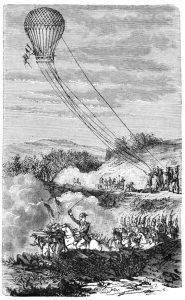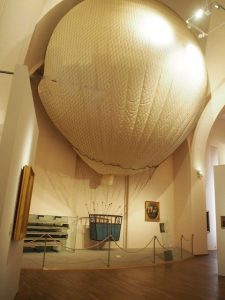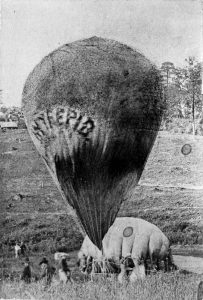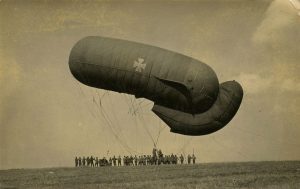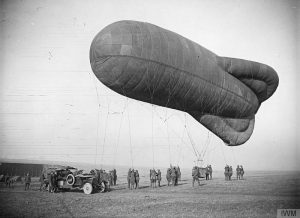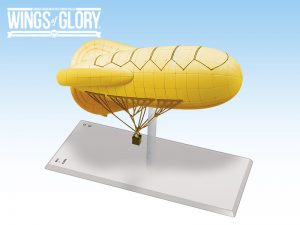The first hot air balloons in the west were created in 1783, when the Montgolfier brothers of Paris first created and launched a balloon with no cargo, then launched a larger one (demonstrating to King Louis XVI) with a sheep, a duck, and a rooster as passengers. A single person—a chemistry and physics teacher-- went up in a tethered flight next, followed shortly by a free flight occupied by the same teacher and a military officer.
From the earliest days, armies have looked for ways to use balloons to their advantage. Just ten years later, the French would use an observation balloon at the Battle of Fleurus, in 1794, although the results were… mixed. Tethered to the highest hill behind the French lines, it appears no actually useful information about enemy movements was gained. Things were just too confusing on the ground, and the unsteady platform did not contribute to a better view.
The balloon was used again the next year, during the Siege of Mainz, and that balloon (or, more likely, a reproduction) is now on exhibit at the Military History Museum in Vienna. Napoleon dismissed the balloon corps as useless, though he did investigate the potential of sending large numbers of troops across the Channel in balloons to invade England!
The Austrians took a deep interest in balloons themselves and intended to purchase many from French aeronaut Eugene Godard, only to find his wares used against them in the 1859 war with France. Godard’s balloons were also used during the Franco-Prussian War and the siege of Paris, both for observation and to convey messages and people in and out of the city.
The early years of the American Civil War are also famous for observation balloons, featuring both new technology—mobile gas generators—and new tactics, the first use of directing artillery to fire on targets they could not see themselves, first done with flag signals and then with a telegraph on the balloon. While this seems to predict balloon use in WW1, the systems were awkward enough that the US Army got tired of the experiment and ceased all balloon operations after 1863. The Confederate States managed only a couple balloons, famous for being made with “wedding dress silk,” but lack of material and lack of gas generating facilities doomed them to quick failure.
Of particular note on these ACW balloons is that a young Count Zeppelin, acting as an ‘observer’ in the US, took his first flights (and inspiration for something even more mobile.)
The British continued development of observation balloons, using them on several African colonial conflicts and the 2nd Boer War, but being handicapped by continuing to use unstable spherical balloons. The French stopped using balloons as soon as they developed observation airplanes, but then realized the balloon’s ability to stay up for hours made it also a useful device.
What we would later call the “kite balloon” was developed in Germany in 1893, by August von Parseval and Rudolph Sigsfeld, and Parseval’s name would go on the earliest successful models. Being non-spherical made a huge difference in effectiveness.
The name “kite balloon” comes not only from being tethered but also by the construction of the balloon that maintains a slight upward angle into the wind, providing both more lift and also stability. The cylindrical shape earned the balloons nicknames like “sausages” with English and French, and “drachen” (or dragons) with the Germans (there was another soldiers’ nickname for the balloons which cannot be printed in a family publication!). Early drachen had fixed fins but later versions had an inflatable sock at the rear which acted as a tail fin and helped keep the balloon pointed into the wind and stable.
Early on, both the French and British merely copied the Parseval, but French Captain Albert Caquot developed a much-improved design that replaced the tubular sausage-shaped envelope with a more aerodynamic teardrop shape and replaced the sock with three fins, which were also held rigid by the wind blowing past. The Caquot design would become the standard observation balloon for all sides.
Balloon defensive tactics involved massive amounts of ground-based machine guns and rapidly firing artillery, along with powerful winches to pull the balloon to safety, and parachutes to protect the observers (first being used by the Germans and followed by the allies). Standard procedure involved the observers jumping as soon as enemy planes came near while the balloon was rapidly pulled down and the ground gunners went to work. Both sides often placed fighters on patrol in the vicinity of balloons and destroying them was so challenging that both sides gave “credit” equal to destroying an enemy plane for destroying a balloon. While many pilots dreaded the risk, certain aces on both sides made a reputation for themselves as “balloon busters,” including Belgium's Willy Coppens, Germany’s F. Ritter von Roth, America’s Frank Luke, and France’s Leon Bourjade.
Of course, something so valuable and so well-protected motivates technology to destroy it. The British worked on special types of machine gun ammunition while the French developed the Le Prieur rocket, which was essentially a large “fireworks” kind of device with a knife edge on the nose to—it was hoped—cut the balloon fabric to release gas that the bursting rocket would ignite. First used by a special flight of all aces, the rockets had a huge effect at the Battle of Verdun, first by shooting down six balloons quickly and seeing the panicky Germans pull down the rest of their fleet for 100km…right before a French counterattack at Fort Douaumont.
Le Prieur rockets were all fired by a single switch, but did not all ignite at once, forcing the attacking plane to hold steady until they were all gone. The ‘arc’ of fire on the rockets (quickly downward!) encouraged pilots to attack from a high angle and point their plane over the target, which is why in Wings of Glory you cannot fire your machine gun on the same attack as you fire rockets. Increasingly available and effective incendiary bullets soon removed the value of the rockets.
Even while observation planes and cameras improved in effectiveness during the war years, neither side gave up the use of observation balloons. For the next war, balloons turned into defensive tools, as the “barrage balloon” was hung over important areas to discourage low-flying airplanes. (You can see a number of them over the beaches at Normandy after D-Day).
Observation Balloons in Wings of Glory
Balloons provide a real upgrade in visual appeal and bring an entirely new focal point for scenarios in Wings of Glory. Balloons do not move, except to go lower and escape to safety. This provides a built-in “target” for scenarios but also adds a time-critical element. If the planes do not worry about running out of fuel or bullets, now players do have something in which time is a key component of play. The very limited amount of time available (even better if there is an uncertain variable) demands that attackers are not subtle in their approaches. But then, given that balloons are usually positioned with heavy defenses and some fighter protection, players still have to consider how best to approach them and achieve success… while still making it back home.
The players who own the balloons will always have some ground defenses that they can place, and deciding the best location makes for interesting strategy - place defenses evenly, or put a more powerful combination for part of the defensive circle and count on fighters covering the weaker spots?
Wings of Glory scenarios tend to escalate in planning the more elements are included. Players can have a simple “fur ball” with all fighters and no objectives except “shoot down the enemy.” Or they can add two-seaters and play “escort/intercept” and see if the two-seaters can take their photos and make it home — not only more interesting but far more historical. Balloons add yet another layer of potential complexity — and fun!
Information sources: "A History of Aeronautics", Vivian, Evelyn Charles, Collins 1921, Part III, Chapter VII, "Kite Balloons"; "Balloons and Airships 1783–1973", Ege, Lennart (1973), Blandford Colour series - The Pocket Encyclopaedia of World Aircraft in Colour; "The World's greatest war from the outbreak of the war to the Treaty of Versailles", Thompson, Holland (1920); "A History of Aeronautics", The World Wide School, November 1997; "Early military ballooning", Royal Air Force Museum; "Balloons in the American Civil War", CivilWar.com.
Images: * Fulgence Marion (pseudonym of Camille Flamarrion), Public domain, via Wikimedia Commons; ** Photo by Kevin Duke; *** Europeana 1914-1918, CC BY-SA 3.0, via Wikimedia Commons; **** John Warwick Brooke, Public domain, via Wikimedia Commons.


